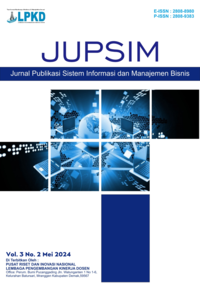Model Manajemen Wisata Halal Berkelanjutan: Analisis Literatur Konseptual dan Praktis
DOI:
https://doi.org/10.55606/jupsim.v4i2.4097Keywords:
Halal Tourism, Sustainability, Tourism Management, Sustainable Tourism, Management ModelAbstract
Halal tourism has emerged as a rapidly growing market segment within the global tourism industry. However, its development often focuses primarily on fulfilling the basic needs of Muslim travelers, without sufficiently addressing broader sustainability considerations. This article aims to analyze both conceptual and practical literature related to the sustainable management of halal tourism, identify research gaps, and propose a comprehensive management model. Through a systematic review of relevant scholarly articles, key dimensions of sustainability—economic, social, environmental, and spiritual—are identified as essential components to be integrated into halal tourism development. The proposed model emphasizes the importance of stakeholder collaboration, the application of technology, and the preservation of Islamic values in creating authentic and responsible tourism experiences. This article contributes to a deeper understanding of how halal tourism can be managed sustainably to generate long-term benefits for communities, the environment, and the tourism industry.
References
Battour, M., & Ismail, M. N. (2016). Halal tourism: Concepts, practises, challenges and future. Tourism Management Perspectives, 19, 150–154. https://doi.org/10.1016/j.tmp.2015.12.008
Battour, M., Ismail, M., & Battor, M. (2010). Toward a halal tourism market. Tourism Analysis, 15, 461–470. https://doi.org/10.3727/108354210X12864727453304
Battour, M., Ismail, M., & Battor, M. (2011). The impact of destination attributes on Muslim tourist’s choice. International Journal of Tourism Research, 13. https://doi.org/10.1002/jtr.824
Budovich, L. (2023). The impact of religious tourism on the economy and tourism industry. HTS Teologiese Studies / Theological Studies, 79. https://doi.org/10.4102/hts.v79i1.8607
Cassen, R. H. (1987). Our common future: Report of the World Commission on Environment and Development. International Affairs, 64(1), 126. https://doi.org/10.2307/2621529
Choi, H. C., & Sirakaya, E. (2006). Sustainability indicators for managing community tourism. Tourism Management, 27(6), 1274–1289. https://doi.org/10.1016/j.tourman.2005.05.018
Duman, T. (2012). The value of Islamic tourism: Perspectives from the Turkish experience. ICR Journal, 3(4), 718–739. https://doi.org/10.52282/icr.v3i4.513
El-Gohary, H. (2016). Halal tourism, is it really halal? Tourism Management Perspectives, 19, 124–130. https://doi.org/10.1016/j.tmp.2015.12.013
Grasso, F., & Schilirò, D. (2023). Tourism, environment, and sustainability. In E. G. Popkova (Ed.), Smart green innovations in Industry 4.0 for climate change risk management (pp. 11–25). Springer International Publishing. https://doi.org/10.1007/978-3-031-28457-1_2
Henderson, J. (2010). Sharia-compliant hotels. Tourism and Hospitality Research, 10, 246–254. https://doi.org/10.1057/thr.2010.3
Henderson, J. C. (2016). Halal food, certification and halal tourism: Insights from Malaysia and Singapore. Tourism Management Perspectives, 19, 160–164. https://doi.org/10.1016/j.tmp.2015.12.006
Jeurissen, R. (2000). John Elkington, Cannibals with Forks: The Triple Bottom Line of 21st Century Business. Journal of Business Ethics, 23(2), 229–231. https://doi.org/10.1023/A:1006129603978
Miller, G., & Twining-Ward, L. (2006). Monitoring for a sustainable tourism transition: The challenge of developing and using indicators. Tourism and Hospitality Research, 7. https://doi.org/10.1079/9780851990514.0000
Mohsin, A., Ramli, N., & Alkhulayfi, B. A. (2016). Halal tourism: Emerging opportunities. Tourism Management Perspectives, 19, 137–143. https://doi.org/10.1016/j.tmp.2015.12.010
Pew Research Center. (2011). The future of the global Muslim population. Pew Research Center.
Putra, M., & Tucunan, K. (2021). The concept of halal tourism and the fulfillment of Muslim tourist needs in halal tourism. Halal Research Journal, 1, 56–62. https://doi.org/10.12962/j22759970.v1i2.52
Saher, S., Zafar, B., & Tharwani, M. (2020). Factors affecting on religious tourism in Malaysia: A case study of Batu Caves Temple.
Sandikci, O. (2021). Religion and everyday consumption ethics: A moral economy approach. Journal of Business Ethics, 168(2), 277–293. https://doi.org/10.1007/s10551-019-04422-2
Setiawan, F., Qadariyah, L., Nahidloh, S., Dzikrulloh, Holis, & Jumanto, J. (2024). Towards SDG sustainable halal tourism development: Integration of sustainability and religious morality. Journal of Lifestyle and SDGs Review, 5(2), e02893. https://doi.org/10.47172/2965-730X.SDGsReview.v5.n02.pe02893
Shah, S., Fianto, B., Sridadi, A., & Kayani, U. (2022). A master conceptual framework of research in halal tourism. Tourism. https://doi.org/10.37741/t.71.1.8
Swarbrooke, J. (1999). Sustainable tourism management. CAB International. https://doi.org/10.1079/9780851993140.0000
Widodo, W., Helmi, S., Lubis, A., & Lumbanraja, P. (2022). Halal tourism: Development, challenges and opportunities. Frontiers in Business and Economics, 1, 50–58. https://doi.org/10.56225/finbe.v1i2.85
Wilson, J. A. J., & Liu, J. (2010). Shaping the halal into a brand? Journal of Islamic Marketing, 1(2), 107–123. https://doi.org/10.1108/17590831011055851
World Tourism Organization. (2005). Making tourism more sustainable: A guide for policy makers. World Tourism Organization.
World Tourism Organization. (2024). International tourism highlights (2024th ed.). UN Tourism. https://doi.org/10.18111/9789284425808
Downloads
Published
How to Cite
Issue
Section
License
Copyright (c) 2025 Jurnal Publikasi Sistem Informasi dan Manajemen Bisnis

This work is licensed under a Creative Commons Attribution-ShareAlike 4.0 International License.







